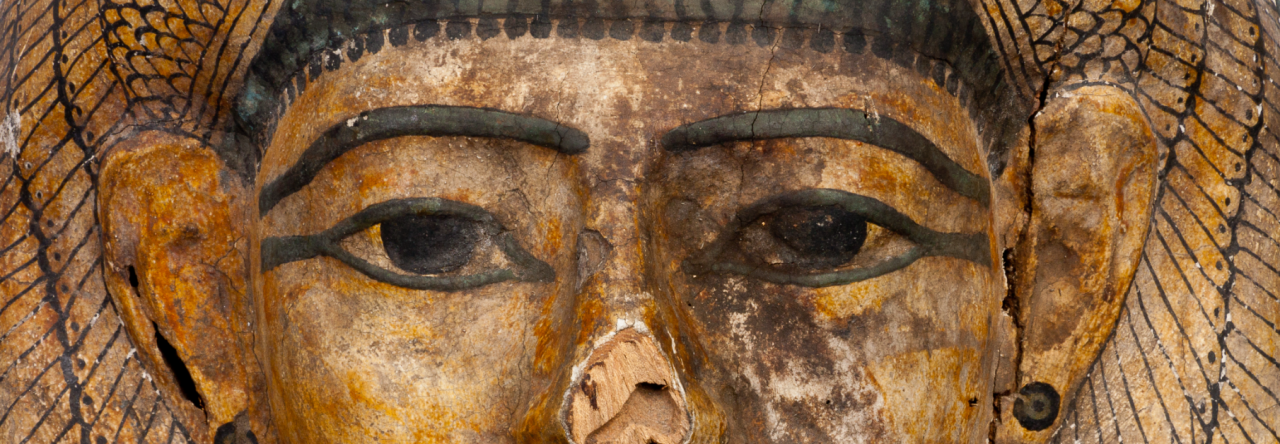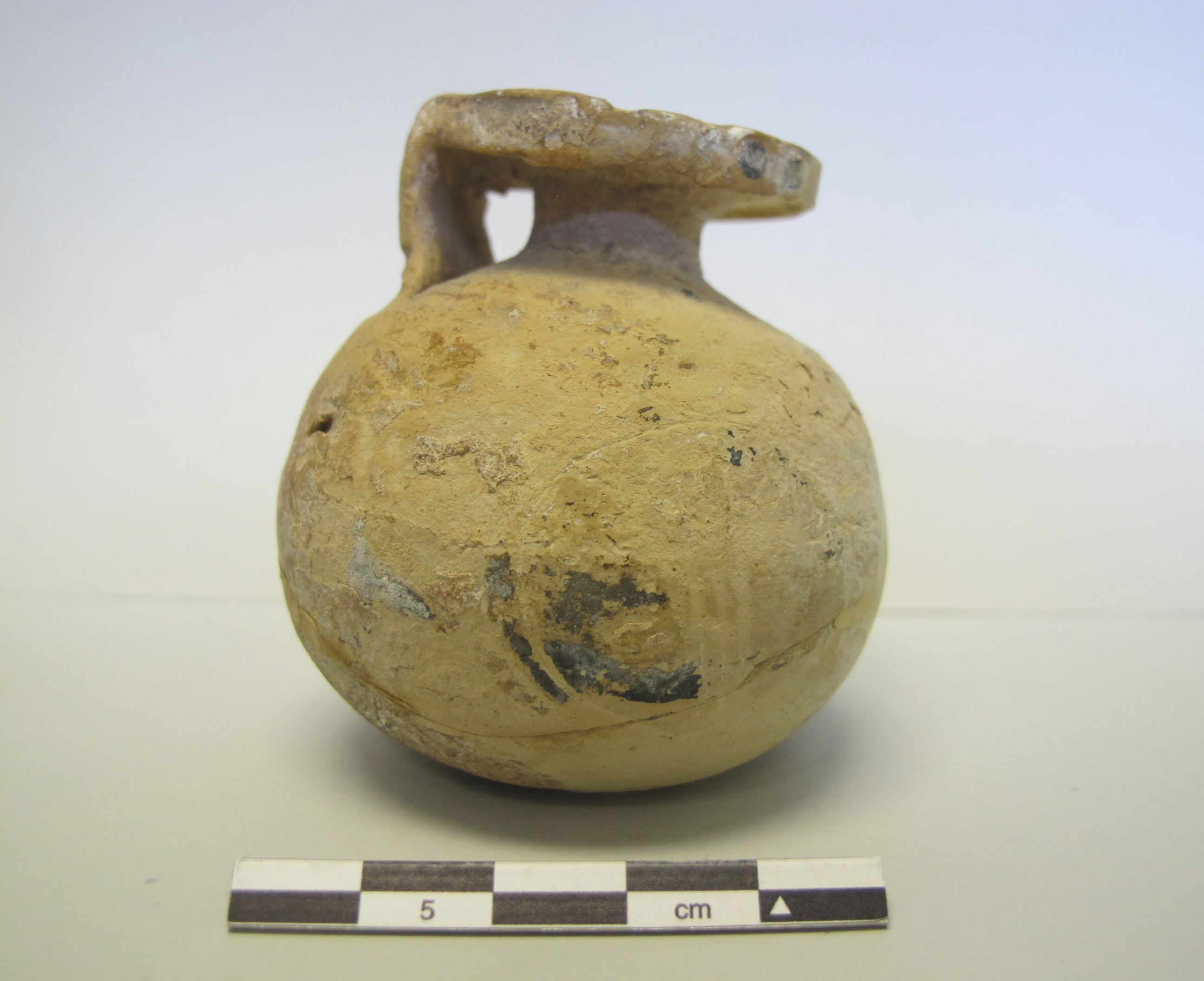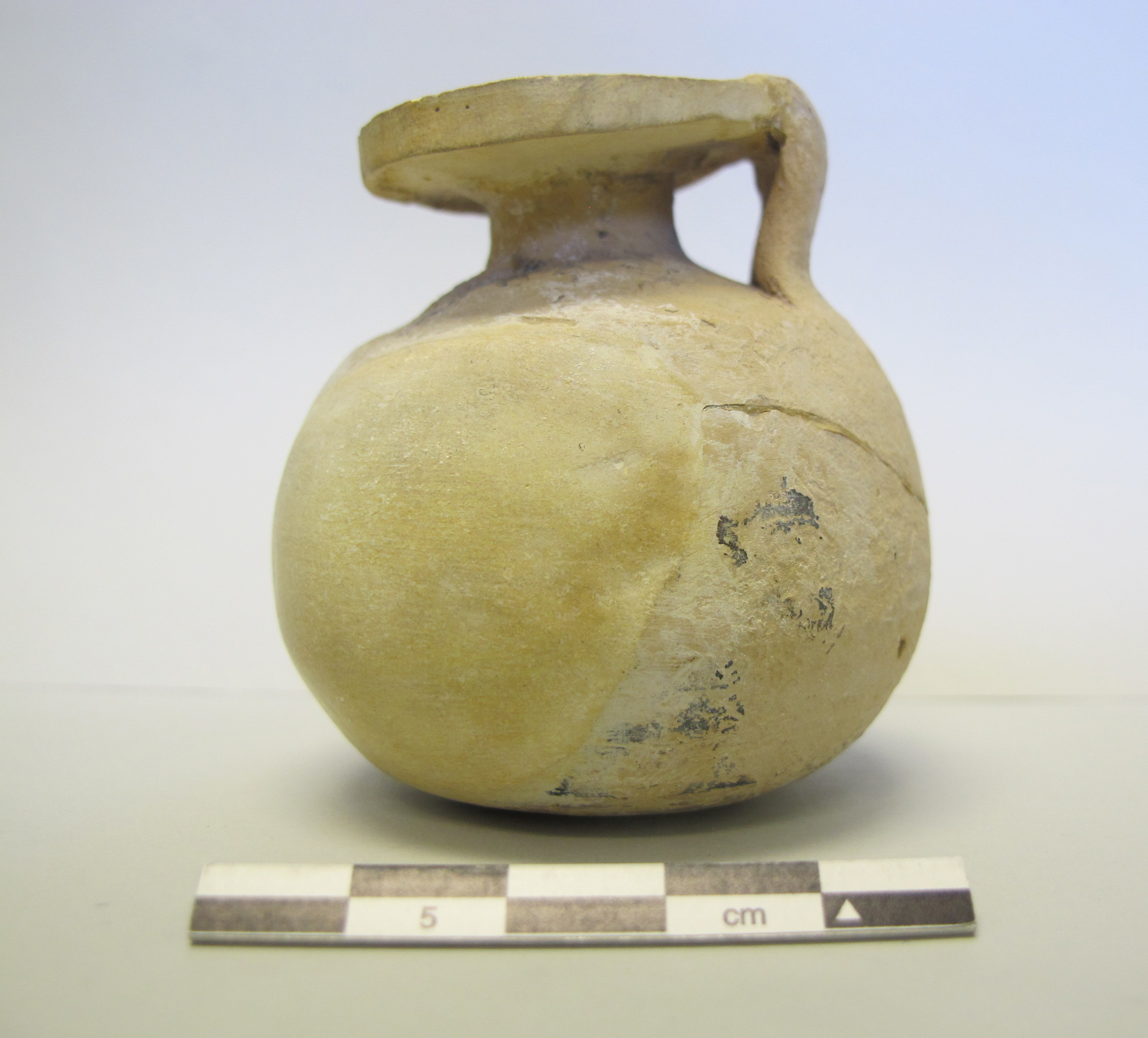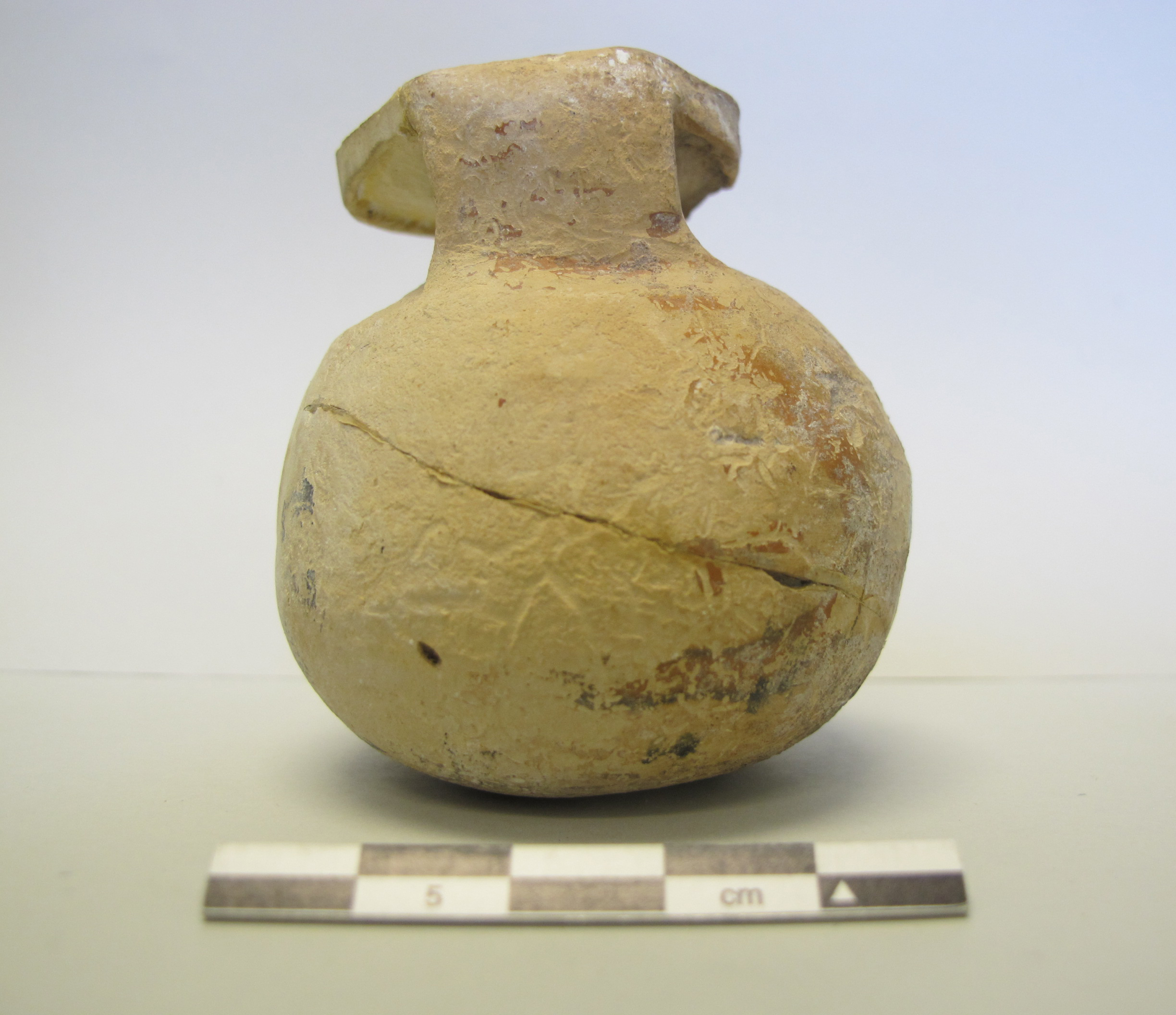For additional photos of this item, see https://library.artstor.org/public/31567614
For a 3D model made by the Virtual Curation Lab at Virginia Commonwealth University, see https://sketchfab.com/3d-models/corinthian-aryballos-vcu-3d-6306-717c9c84468b447cb860a1a37d071b05
AWG0000.01.08 (UR6012)
Greek, Corinthian
Archaic period (early to mid 6th c. BCE)
Material: Ceramic
Technique: Black-figure
Weight: 77g
Dimensions: 5.3 cm high, base diameter 6 cm, rim diameter 4 cm
Condition: Poor condition; though most of the slip has worn away, incisions hint at the original black-figure design. Half of the rim and part of the body have been restored with plaster filling painted to match the buff clay color.
Provenance: Unknown
Source/donor: Unknown
Date of acquisition: The inventory number beginning with R suggests that it was part of the Richmond College Museum collection. Other R-numbered items were displayed in the Biology Museum in Maryland Hall beginning in 1932.
Research by: Lindsey Stevens, ’23
Detailed description of form/shape:
Globular body, with small neck and large, circular, and flat mouth with squared edge. Broad flat handle connects the body to the mouth. Round bottom with slight concavity in center.
Detailed description of decoration:
Black-figure quatrefoil on one side of the body (incisions remain but most of the black slip has flaked off). Horizontal black bands circle the bottom of the aryballos and the flat upper surface of the mouth. Black dots around the vertical edge of the lip.
Comparanda:
For aryballoi of similar shape and quatrefoil design, see Payne 320; Boardman fig. 368; and Beazley Archive Pottery Database vase nos. 1002269, 1000797, and 1001818. The last also has dots on the rim. For other quatrefoil aryballos with dots on the rim edge, see Lyon X 482-54 and Manchester 37040 (Rasmussen fig. 30). Dots on the rim edge also appear in combination with figural decoration on the body, e.g. Beazley Archive Pottery Database vase no. 1003348.
Discussion:
An aryballos is a small oil flask used by ancient athletes for the olive oil with which they covered their bodies before practicing or competing. After exercising, they would remove the oil and accumulated dust and sweat with a metal scraper (called a stlengis or strigil). The flask could easily be toted with a small strap wrapped around the neck of the vase. To see a painted figure using an aryballos for oil in athletic games and a display of modern replicas hung on strings, see “The Ancient Basis for the Modern Nemean Games.” A marble gravestone in the The Metropolitan Museum of Art (11.185) illustrates how an athlete would carry an aryballos on a strap.
Although the painted decoration on this vase is very worn, surviving traces suggest a quatrefoil pattern common on Late Corinthian aryballoi of the late 7th and 6th century BCE. The pale yellow fabric of the clay also aids in identifying the vase as Corinthian.
The quatrefoil motif carries different connotations in different regions and religious contexts, but it often symbolizes wealth and fanciness, due to the intricacy of the design and the preciseness with which the symbol must be drawn or carved. In Corinth, quatrefoil ornament was probably inspired by Near Eastern models, derived from the “design of alternate lotus flowers and cones seen on carved threshold slabs from Assyrian palaces” and likely transmitted via textiles (Rasmussen 76; compare, for example, the motifs in the center squares on Metropolitan Museum of Art X.153; for exploration of Near Eastern elements in Corinthian vase painting, see Markoe 1996).
Corinthian aryballoi with quatrefoil and other floral motifs, produced in great quantities in the first half of the sixth century and continuing even after ca. 550, were “exported in enormous numbers and quite often ended up in burials in large numbers as well,” with one burial in Boiotia containing more than 250 Corinthian aryballoi of various types (Rasmussen 77-78). As time went on, the quatrefoil designs on Corinthian aryballoi got simpler and less intricate, even sloppy, as they were produced more frequently; “the humble quatrefoil aryballos . . . can best be studied not as a work of art but as an unpretentious container that is found in archaeological contexts that raises questions about Greek religious and funerary practice” (Sparkes 227).
Bibliography:
Beazley Archive Pottery Database. Oxford: Classical Art Research Centre. https://www.carc.ox.ac.uk/carc/pottery.
Boardman, John. 1998. Early Greek Vase Painting. London: Thames and Hudson.
Love, Michael, and Julia Guernsey. 2007. “Monument 3 from La Blanca, Guatemala: A Middle Preclassic Earthen Sculpture and Its Ritual Associations.” Antiquity 81 (314): 920–32.
Markoe, Glenn. 1996. "The emergence of orientalizing in Greek art: Some observations on the interchange between Greeks and Phoenicians in the eighth and seventh centuries BC." Bulletin of the American Schools of Oriental Research 301 (1): 47-67. https://doi.org/10.2307/1357295.
Mars, Roman. 2014. “The Quatrefoil Is the Fanciest Shape.” Slate. March 20, 2014. http://www.slate.com/blogs/the_eye/2014/03/20/the_quatrefoil_is_the_fanciest_shape_99_invisible_by_roman_mars.html.
Payne, Humphrey. 1931. Necrocorinthia: A Study of Corinthian Art in the Archaic Period. Oxford: Clarendon Press.
Rasmussen, Tom. 1991. “Corinth and the Orientalizing phenomenon,” in Looking at Greek Vases, edited by Tom Rasmussen and Nigel Spivey, 57-78. New York: Cambridge University Press.
Sparkes, Brian A. 1993. Review of Looking at Greek Vases, by Tom Rasmussen and Nigel Spivey. The Journal of Hellenic Studies 113: 227–228. https://doi.org/10.2307/632460.
The Metropolitan Museum of Art 11.185 “Marble stele (grave marker) with a youth and little girl, and a capital and finial in the form of a sphinx,” from Attica.
The Metropolitan Museum of Art X.153, “Threshold pavement slab with a carpet design,” probably from Nineveh.
The Society for the Revival of the Nemean Games. 2014. “The Ancient Basis for the Modern Nemean Games - Revival of the Nemean Games.” https://nemeangames.org/nemean-games-revival/ancient-basis.html
Volioti, Katerina. 2014. “A new signed Corinthian aryballos.” Talanta - Proceedings of the Dutch Archaeological and Historical Society 46:107-120.





